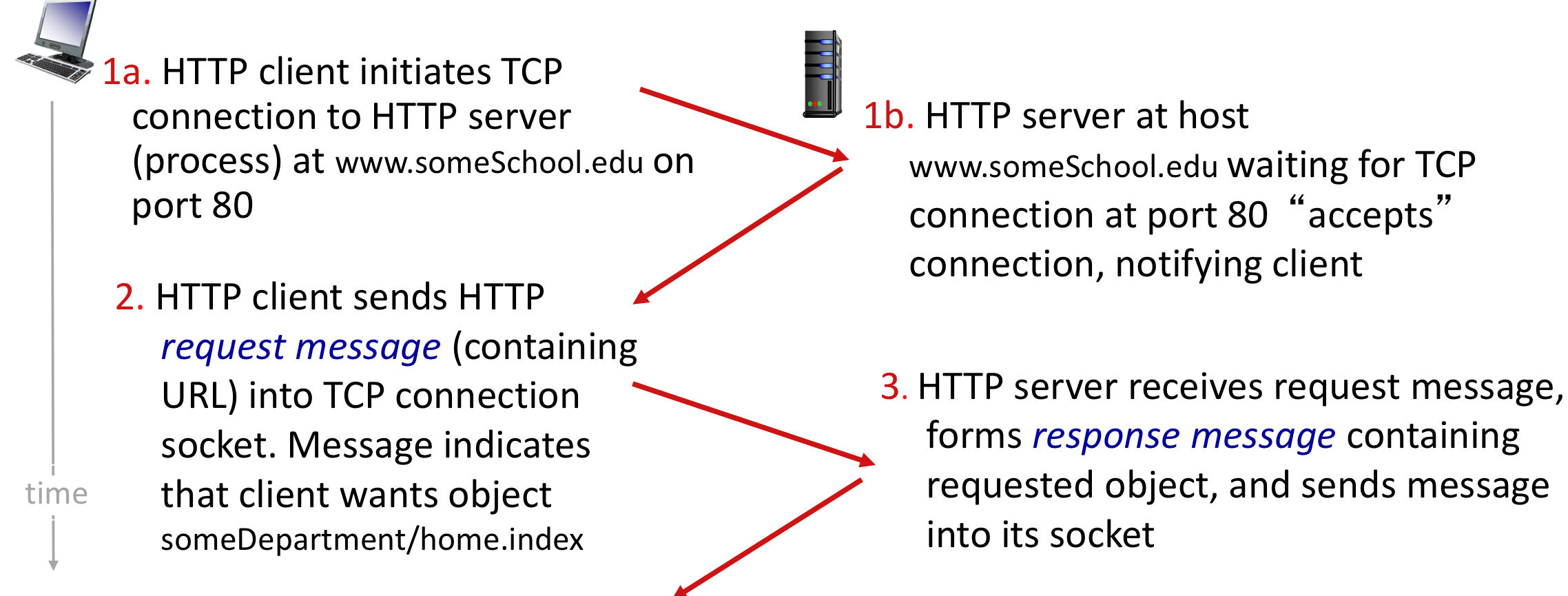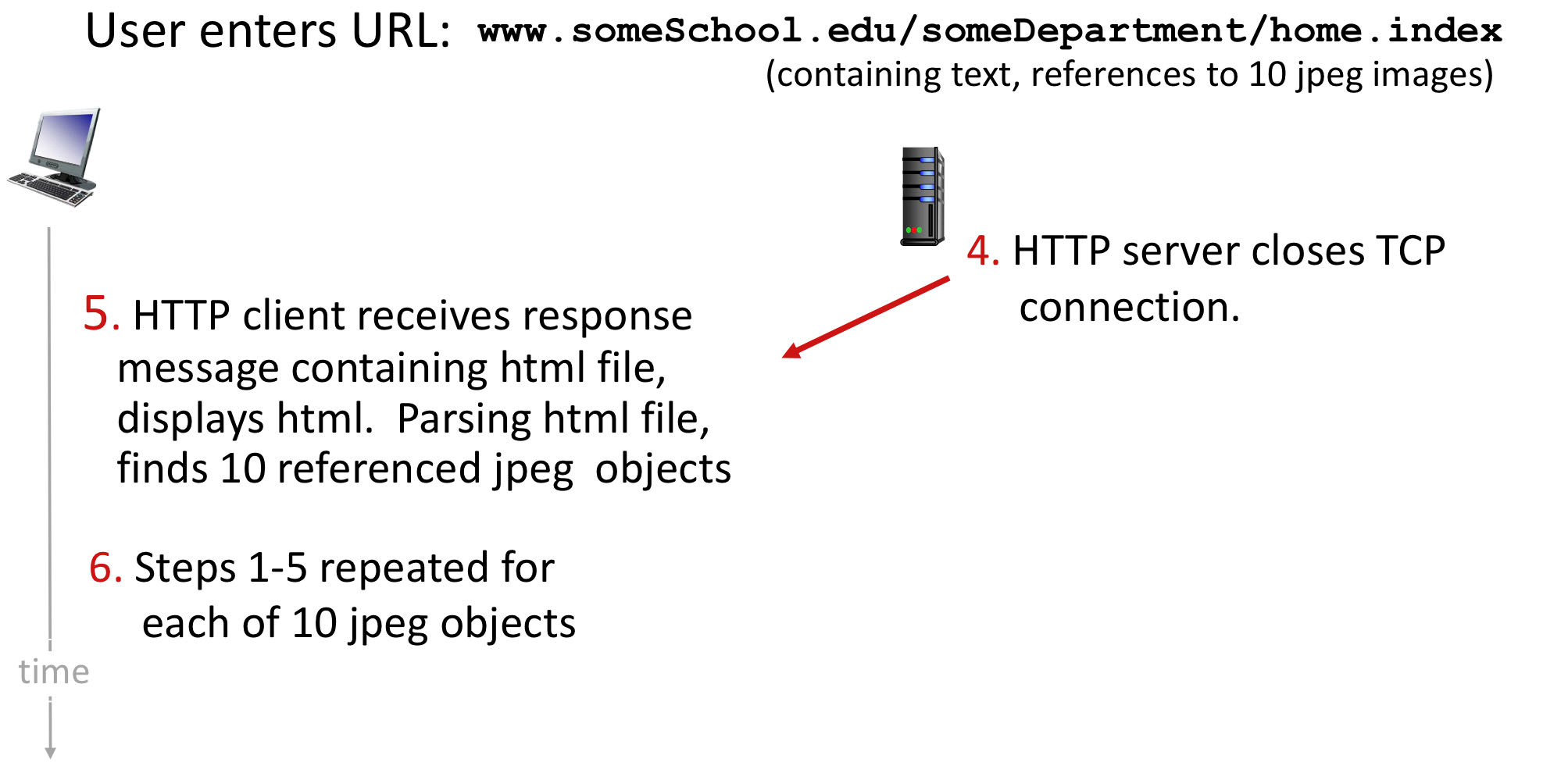Application Layer¶
Principles of Network Applications¶
Writing programs that:
- run on different end systems
- communicate with each other over network
No need to write software that runs on network-core devices.(routers, link-layer switches)
- Actually, those network-core devices cannot run user applications
Network applications Architecture¶
On how the application is structured over the various end systems.
Client-server Paradigm¶
Server: always on host, permanent IP address, and located in data centers
Client: contact with servers, dynamic IP address
Peer2Peer(P2P) Architecture¶
minimal reliance on dedicated servers.
Self scalability: new peers bring new service capacity, as well as new service demands
Processes Communicating Interfaces: Socket¶
analogue to "door"
assume that transport infrastructure on the other side of the "door"
Two sockets: one on sender side, and one on receiver side
Addressing System¶
IP address to identify the "host"(32 bits)
port number to identify the "application"
Transport-layer services expected/Required¶
- reliable data transfer
- throughput
- timing
- security

(TCP services, UDP services)
(TLS services)
Application-Layer Protocol¶
Defines:
- type of messages exchanged: e.g. request & response
- message syntax: what fields are in message
- message semantic: meaning of information in fields
- rules: for when & how processes send

Web and HTTP¶
Web Page¶
Object: file;
Web page: several objects, (may on different server)
- base HTML file
- several referenced objects, addressed by a url
- student.cs.uwaterloo.ca[host name]/~cs251/F22/a1.pdf[path name]
HTTP overview¶
define how Web clients request web pages and how servers transfer Web pages(response) to clients
-
Web client: web browsers
-
Web server: house server objects.
Stateless protocol: maintain no information about the clients
Transport Layer¶
TCP, port (usually) 80
| Non-persistent | Persistent |
|---|---|
  | HTTP/1.1 server leaves the connection open after sending response subsequent HTTP messages between same client/server sent over open connection client sends requests as soon as it encounters a referenced object close connection when not use for certain time. |
 2RTT + file transmission time (per object) | one RTT for all referenced objects |
| overhead for each TCP connection | occupancy issue |
HTTP Message Format¶
Request:

Methods:
- POST method: input/form
- HEAD method: response will only include a header (of GET method)
- GET method: get objects
- can send parameters/data in url:
?asdasd=1131&asdasd=13&
- can send parameters/data in url:
- PUT method: uploads new file(object) to server
Response:

Status code:
- 200 OK
- 301 Moved permanently
- 400 Bad Request
- 404 Not Found
- 595 HTTP Version Not Supported
States in HTTP: cookies¶
System:
- cookie header line of HTTP response message
- cookie header line in next HTTP request message
- cookie file kept on host/client, managed by browser
- back-end database at Web site
Application:
- authorization
- shopping cart
- recommendations
- user session state
Web Caching¶
Proxy server: keep copies of recently requested objects in its storage
Why: reduce response time, reduce traffic of access link
Purchased and installed by ISP
Note
Calculation: the performance of a "cache"
reduce the "access link" delay (extremely high if utilization is high)
Conditional GET:
If-Modified-Since: header line
if cache is up-to-date: return HTTP/1.0 304 Not Modified
HTTP/2¶
Goal: reduce latency by enabling multiplexing over a single TCP connection
Key points:
- Not modified: methods, status codes, most header fields
- Modified parts:
- transmission order can base on client-specified object priority (not necessarily FCFS)
- push unrequested objects to the client(not only send when request)
- divide objects into frames, schedule frames to mitigate HOL(Head of line. a big files in the start of data) blocking [instead of multi-tcp connection]
HTTP/3:
- add security
- per object error- and congestion control over UDP
Email, SMTP, IMAP¶
Three major components: user agents, mail servers, Simple Mail Transfer Protocol.
User Agents: mail reader
Mail server: mailbox, message queue
SMTP: client & server
SMTP¶
(Use TCP, port 25)
Process:
- construct TCP connection
- application-layer handshaking
- indicate sender's address
- send message
MAIL FROM: <cqqqwq@outlook.com>RCPT TO: <cqqthu20@mails.tsinghua.edu.cn>DATA- data lines
.QUIT
Message itself: in data lines
- Header lines
- To:
- From:
- Subject:
- ...
- BLANK LINE
- Body:
Mail Access Protocols¶
Two ways to retrieve emails:
- IMAP: Internet Mail Access Protocol, provide retrieval, deletion, folders of stored messages on server
- HTTP: Gmail, Hotmail...'s web-based interfaces
DNS¶
DNS system:
- A distributed database implementation in a hierarchy of DNS servers.
- Root server: contact-of-last resort
- Top Level Domain:
.com/.ca/.uk - Authoritative: organizations
- Local DNS server:
- belongs to ISP, the target of user DNS query
- has local cache, act as proxy
- Reason:
- avoid single point of failure
- an application-layer protocol that allows hosts to query the distributed database
Runs over UDP, use port 53
Service:
- a map from hostname to IP address(host)
- host aliasing
- Mail server aliasing
- load distribution
DNS Record & Message¶
format: (name, value, type, ttl)
Type:
- A:
name-> hostname,value-> IP address - NS:
name-> domain(foo.com),value-> hostname of authoritative name server for this domain - NAME
name-> alias name for some canonical(real) name,value-> canonical name - MX:
value-> the mail server associated withname
Message contain several records

DNS caching & name resolution method¶
Recursive Query: root asks its son, and so on.
Iterative Query: I don't know this name, but ask this server
Create DNS server¶
add a NS record to DNS hostname
add a A record to find DNS authoritative server
Peer to Peer Architecture¶
Definition: Peers request service from other peers, and provide service in return to other peers
- Self-scalability: new peers bring new service capacity, and new service demands
Example -- File distribution¶
Time to distribute F to N clients using client-server approach: $$ D_{\text{c-s}} \geq \max{\frac{NF}{u_s}, \frac{F}{d_{\min}}} $$ \(NF\) increases linearly in \(N\), the scale of the system
Time to distribute \(F\) to \(N\) clients using P2P approach: $$ D_{\text{P2P}}\geq \max{\frac{F}{u_s},\frac{F}{d_{\min}},\frac{NF}{u_s+\sum u_i}} $$ chunks
sending chunks: tit-for-tat---sends chunks to those four peers currently sending her chunks at highest rate
every 10 seconds reevaluate
every 30 seconds randomly select another peer, starts sending chunks
Video Streaming and CDNs¶
Challenge: scale, heterogeneity
Solution: distributed, application-level infrastructure
DASH¶
Dynamic, Adaptive Streaming over HTTP
Server:
- chunks(different part, different rate)
- manifest file: provides URLs for different chunks
Client:
- periodically measures server-to-client bandwidth
- request maximum coding rate (chunk), that is sustainable given current bandwidth
intelligent client: can choose when/what rate/where to request
encoding + DASH + playout buffering
Content Distribution Networks¶
Store/serve multiple copies of videos at multiple geographically distributed sites
enter deep: push CDN servers deep into many access networks (close to users)
bring home: smaller number (10) of larger clusters in POPs near(but not within) access networks
Example: a CNAME record for the resources